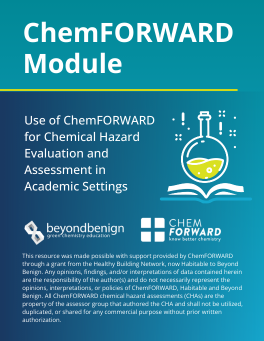ChemFORWARD Module Overview

Summary
The ChemFORWARD module aims to help instructors teach students how to use the ChemFORWARD platform to obtain hazard information for specific chemicals, and to identify safer chemicals to replace chemicals of concern in research and in product formulations.
The module is organized into two units. Each unit contains a unit overview, specific learning outcomes, course alignment, prerequisites, lecture slides, assessment/review questions, instructor notes, and a list of additional resources. Assessment/review questions can be used on quizzes, exams, or in lecture. The assessment/review slides can be used as clicker questions for in-class feedback. Assignments could be used as group activities or as homework assignments. CAS Registry Numbers for pertinent chemicals cited in the lecture slides, assignments, and review/assessment questions are listed at the end of this document.
The module also provides background materials on hazard, risk, and chemical alternatives assessment, as well as links to available resources on toxicology.
This module was reviewed by Julian Silverman (Ph.D.) and Sarah Prescott (Ph.D.).
The inspiration of this work began with a Forsythia Foundation grant to Habitable (formerly Healthy Building Network) to support Beyond Benign and ChemFORWARD to develop a green chemistry curriculum that leverages from Habitable’s Pharos chemical hazards database combined with ChemFORWARD’s safer alternatives.
For Green Chemistry Commitment (GCC) signers interested in short-term pilot access to the platform for educational purposes, please contact educator@chemforward.org.
The module is organized into two units. Each unit contains a unit overview, specific learning outcomes, course alignment, prerequisites, lecture slides, assessment/review questions, instructor notes, and a list of additional resources. Assessment/review questions can be used on quizzes, exams, or in lecture. The assessment/review slides can be used as clicker questions for in-class feedback. Assignments could be used as group activities or as homework assignments. CAS Registry Numbers for pertinent chemicals cited in the lecture slides, assignments, and review/assessment questions are listed at the end of this document.
The module also provides background materials on hazard, risk, and chemical alternatives assessment, as well as links to available resources on toxicology.
This module was reviewed by Julian Silverman (Ph.D.) and Sarah Prescott (Ph.D.).
The inspiration of this work began with a Forsythia Foundation grant to Habitable (formerly Healthy Building Network) to support Beyond Benign and ChemFORWARD to develop a green chemistry curriculum that leverages from Habitable’s Pharos chemical hazards database combined with ChemFORWARD’s safer alternatives.
For Green Chemistry Commitment (GCC) signers interested in short-term pilot access to the platform for educational purposes, please contact educator@chemforward.org.
Safety Precautions, Hazards, and Risk Assessment
Not applicable as this module could be used to replace a wet lab.
Teacher Recommendations or Piloting Data (if available)
Some notes from initial piloting of the module:
1. Students in an Environmental Toxicology (18) and an Inorganic Chemistry (18) course were given brief background information and then asked to work on one of the three assignments as homework. The assignments were divided between the student teams to balance, as much as possible, feedback on each assignment. Overall feedback was positive.
2. Students in a General Chemistry II (18) course were presented with selected slides and asked to complete the assignment on deodorants. This assignment was modified to include only 5 ingredients with hazard bands ranging from C to ?. Students worked in teams to complete the assignment during an open lab period. It took the teams about 20 minutes to complete the exercise.
1. Students in an Environmental Toxicology (18) and an Inorganic Chemistry (18) course were given brief background information and then asked to work on one of the three assignments as homework. The assignments were divided between the student teams to balance, as much as possible, feedback on each assignment. Overall feedback was positive.
2. Students in a General Chemistry II (18) course were presented with selected slides and asked to complete the assignment on deodorants. This assignment was modified to include only 5 ingredients with hazard bands ranging from C to ?. Students worked in teams to complete the assignment during an open lab period. It took the teams about 20 minutes to complete the exercise.
Digital Object Identifier (DOI)
https://doi.org/10.59877/BXRH1124
Other notes/information
Please refer to the instructor's notes before using the module.
Any opinions, findings, and/or interpretations of data contained herein are the responsibility of the author(s) and do not necessarily represent the opinions, interpretations, or policies of ChemFORWARD, Habitable, or Beyond Benign. All ChemFORWARD chemical hazard assessments (CHAs) are the property of the assessor group that authored the CHA and shall not be utilized, duplicated, or shared for any commercial purpose without prior written authorization.
Any opinions, findings, and/or interpretations of data contained herein are the responsibility of the author(s) and do not necessarily represent the opinions, interpretations, or policies of ChemFORWARD, Habitable, or Beyond Benign. All ChemFORWARD chemical hazard assessments (CHAs) are the property of the assessor group that authored the CHA and shall not be utilized, duplicated, or shared for any commercial purpose without prior written authorization.
File (PDF, PPT, image, etc)
Creative Commons License

This work is licensed under a Creative Commons Attribution-NonCommercial-ShareAlike 4.0 International License.




